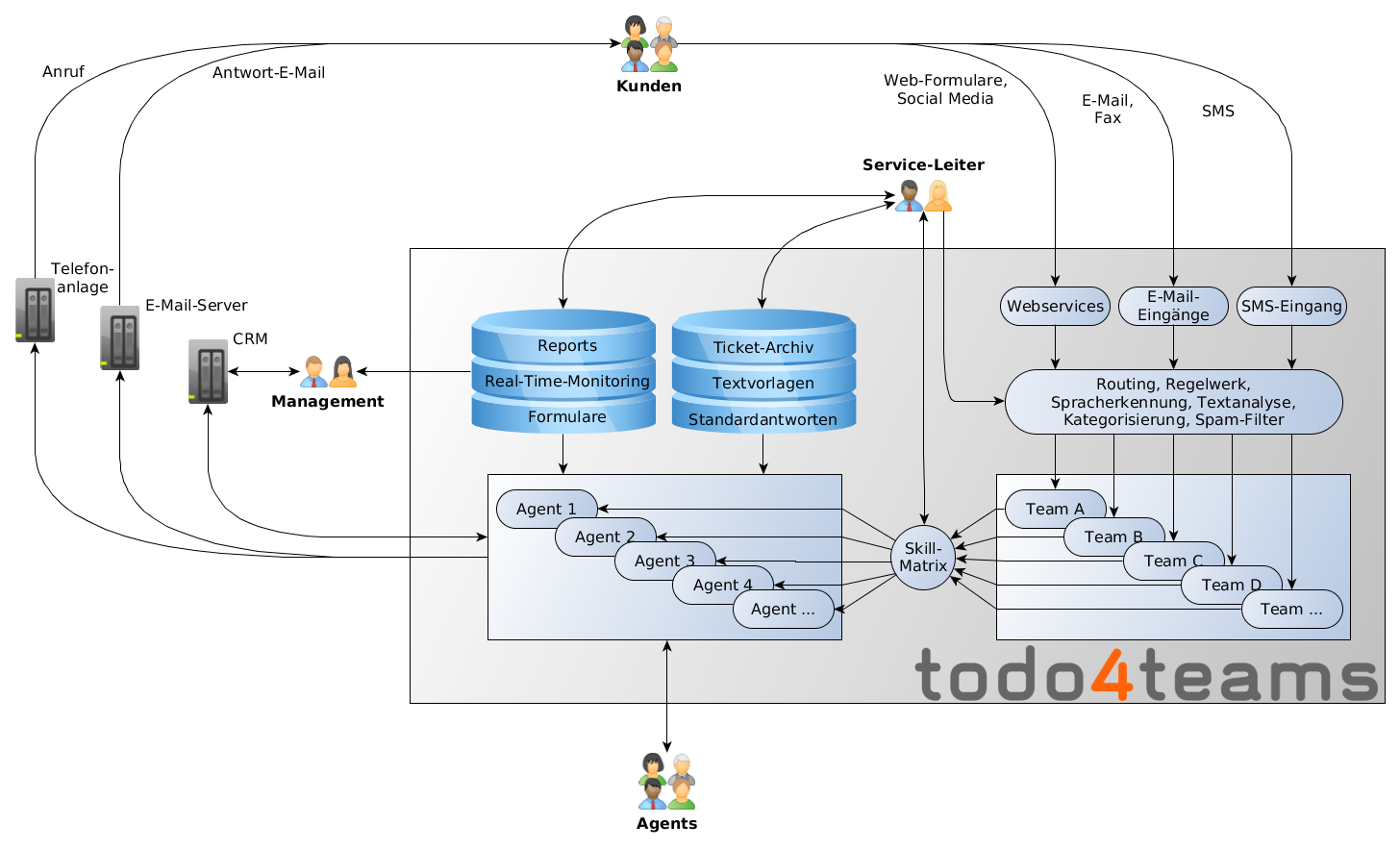E-Mail-Management

Take control of your emails
E-Mail-E-Mail Response Management
Professional email processing is a challenging task even for the individual employee of a company. It is necessary to sort, prioritize, route and mainly react promptly and professionally.
The complexity increases if several dozen thousands of emails are to be processed per day for company wide email addresses. With popular email applications of office software packages this task can not be mastered. In such cases more scalabale solutions are necessary. Email response management systems allow users to handle large amounts of incoming messages by many concurrent users with high efficiency. todo4teams is such a system.
Efficiency and quality
The sender of an email to your company commonly has two major expextations:
- a content satisfactory solution of his concern
- a reasonably short response time
An Email Response Management System (ERMS) must support these tasks in several ways: Optimize the collaboration of large teams of employees to process the flood of messages via an automatic distribution of requests to employees with a corresponding qualification employees.
The key to this is a skill matrix to resolve, which employee is qualified for a certain problem. The development and maintenance of this matrix is expensive for a company with several hundred employees and service often just as many concerns categories. But once created, it is the key to a great service and a good resource planning.
Routing
But how can you assign a certain skill to a certain concern category? If you provide your customers options to address their concerns properly, you can save a lot of effort here. Web forms for contact purposes and special email addresses for different concerns (complaint@yourcompany.com sparepart@yourcompany.com, etc.) are easy to deploy and can be linked directly to skills.
Moreover you can define rules that are tied to keywords in the subject or full text, automatic speech recognition, return addresses or certain attachments.
Messages that are in spite of these rules associated with the wrong skill must be forwarded by the Agents. Ideally, only a small percentage of emails should have to be distributed manually. Real life often provides a different picture, because customers often address their concerns to info@mycompany.com.
Locking concept
An ERMS must provide a locking concept that guarantees that every request will be processed by exactly one agent. Multiple processing of the same email must be reliably prevented.
A message processed by an agent must be exclusively locked for him and disappear within a short time from the task lists of other employees to avoid unnecessary clicks.
Solution support
For a certain skill customers very often have similar questions. A quick-to-use archive of standard texts and sample solutions is therefore always part of a good ERMS. Ideally, sample solutions also include photographs and sketches, so that technical solutions are presented in a standardized way.
Extending beyond these business processes can be designed efficiently and forms a connection to the CRM, service or customer service system of your company. The ERMS should have a maximum flexibility in order to avoid an unnecessary change of workplace applications of the Agents. Thus, for example, the sender address of an email is a good starting point to find the customer in the CRM system and provide the required data in the ERMS. Ideally the developed solution and the answer are automatically stored in the customer history of the CRM.
Monitoring
An ERMS should provide realtime metrics of the service level for all skills in a monitoring instrument. Like cockpit indicators the email traffic, staffing per skill and the current service level should be displayed. The observation of these measures is necessary to take countermeasures quickly if the selected service goal can not be kept. By short-term change of routing rules, the strengthening of certain teams or the change of priorities, the fluctuating loads on the individual skills can be compensated during the day.
Reporting
Reporting (in contrast to monitoring) present the service level data in a historical view. In addition to standard reports (email volume, processed tickets, service level, etc.) an ERMS should provide an interface for a business data warehouse, so that the service codes can be processed together with other financial indicators.
Email response management, concern management and ticketing
How the ERMS is bordered on the general concern management or a ticketing system? First of all, should the ERMS provide all the features of a ticketing system. But especially the email processing functionality is superior and much more elaborated. Ticketing systems generally accept incoming emails and send reply emails. An ERMS is expected to handle even complex formatted emails including images, tables, etc. and created with standard office email applications as e.g. Thunderbird or Outlook. An ERMS should have the ability to format all outgoing emails (font, color, footer including logo etc.) in the corporate design of your company.
Conclusion
A good email response management system represents your company perfectly through quick responses to incoming messages and by high quality responses.
It meets the highest standards of efficiency, transparency and controllability.
We gladly put our email response management and ticketing system todo4teams. Talk to us: kontakt@bergener-bluma.de.
